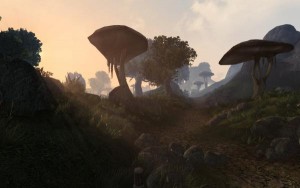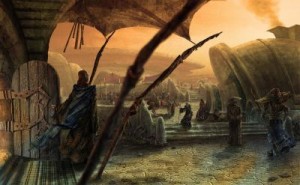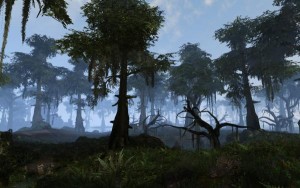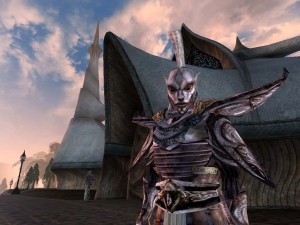Morrowind is one of the truly amazing RPGs among videogames. Over the last 20 years there probably have been hundreds of fantasy videogames, but Morrowind has always been in a category of its own. Even when you look at fantasy works in other mediums, it’s still something very unusual and quite unique. Most recently Skyrim has had a huge impact as the last game of the Elder Scrolls series, but as pretty as the world of that game is, it’s still mostly pretty ordinary European-style medieval fantasy, with Vikings driving out the Roman Empire from their land and some dragons and elves for good measure. Nothing we havn’t seen a thousand times before. But Morrowind, even being set on the same planet and right next door, is a place very much unlike anything else in fantasy. The most similar setting I can think of would be the AD&D world Dark Sun, and you might also consider the venerable common ancestor of all heroic fantasy and space opera Barsoom from A Princess of Mars.
Very obviously on first glance is that Morrowind and these other settings have very unique landscapes and wildlives, as I had mentioned two weeks back. The plants look different and there are many common animals that are not seen as monsters but are completely unlike any animal we have on earth. (Or at least in Europe and North America.) And even more, there is also a noticable absence of almost any animals we are familiar with. But that is only on the very surface and only affects how the world looks. While the visuals in Morrowind look great, it is not all there is to it and this element is mostly irrelevant for stories or campaign settings. Strange looking animals and plants don’t make a difference by themselves in regards to how the world and the people in it tick.
 I’ve been discussing this topic with other people over the last weeks and it resulted in quite a number of very great thoughts, realizations, and discoveries about what you can do to create a world that feels similar to Morrowind without being a direct copy of it. And even if that’s not your intention, any single one of these should be useful as a starting point to making your work more unique and different from the standard medieval European fantasy.
I’ve been discussing this topic with other people over the last weeks and it resulted in quite a number of very great thoughts, realizations, and discoveries about what you can do to create a world that feels similar to Morrowind without being a direct copy of it. And even if that’s not your intention, any single one of these should be useful as a starting point to making your work more unique and different from the standard medieval European fantasy.
Small Civilization
Being a videogames with a single outdoor area you can travel freely made it necessary that settlements in Morrowind are all quite small. Not only were there much greater restrictions on the technology back then, it also would have hugely increased the amount of work for the creators. But in a way, this necessity became a virtue for the game. With all towns and villages consisting of only a few dozen buildings at the most and few people on the streets, they created a unique and even somewhat ethereal atmosphere for the game as a whole. Even thought it’s part of a huge empire, Morrowind appears to be only sparsely settled and it’s population huddled together in a few small clusters of civilization. In fantasy it is very common to have a focus on the big cities with the huge palaces and cathedrals where thousands of people are living in one place, and to deal with the conflicts between great kingdoms. Morrowind isn’t anything like that. Instead, civilization is small and highly decentralized. Vivec may be the greatest city on Vvardenfell, but it’s not the hub around which all politics and business revolves. It’s about small communities that are in contact with each other, but are all very autonomous and are mostly doing their own thing.
 This also means that much of the politics you’re dealing with is local and involves relatively small numbers of people. And as a consequence, interaction with these political intrigues becomes very personal. The players are not in some other city in a different corner of the world, but they are all close together and players have the option to interact with each of them personally. Not just talking with them, but actually having individual personal relationships with them. (Something the Elder Scrolls series is unfortunately almost completely lacking.) Politics and power is not abstract, but something much more concrete that is happening immediately around you.
This also means that much of the politics you’re dealing with is local and involves relatively small numbers of people. And as a consequence, interaction with these political intrigues becomes very personal. The players are not in some other city in a different corner of the world, but they are all close together and players have the option to interact with each of them personally. Not just talking with them, but actually having individual personal relationships with them. (Something the Elder Scrolls series is unfortunately almost completely lacking.) Politics and power is not abstract, but something much more concrete that is happening immediately around you.
Travel
Like all games of the Elder Scrolls series, Morrowind has you traveling through the landscape a lot to get to your destinations. In fact, simply going from one place to another and observing the environment and running into creatures and strange sights is a major element of the games and a big draw of the series. In a lot of fantasy campaigns, and especially modern and sci-fi, the journey between places where the story of the game takes place is often dealt with quite swiftly or even skipped entirely. You leave one place and regardless of whether it takes 10 minutes or 10 weeks, the next scene happens when you arrive at your destination. Perhaps have a random encounter along the way to mix things up a bit. (This is totally not how random encounters should be used.) But for a campaign set in a world like Morrowind, that captuers the unique atmosphere of the game, skipping over all the travel just won’t do.
 The main reason I see for skipping travel in most campaigns is that nothing interesting happens and the players are not encountering anything new. A group of bandits or a pack of wolves attacking is just not interesting. Most people have seen it so many times that such encounters are not noteworthy in any way and unless one of the character has some funny mishap during the encounter there is nothing about it that would be worth remembering. Traveling through a generic fantasy forest or generic medieval fields is just background noise. Nothing that’s worth spending play time on. Running a game inspired by Skyrim or Oblivion would become a problem in this regard. But thankfully, things are quite different when traveling through a world like Morrowind because the environment is so much different from what you usually see in most standard fantasy and what a great number of us are used to seeing when driving on a highway or looking out of a train window. (In particular us Central and Northern Europeans.) In a world like Morrowind everything is a bit different and behaves in ways that are not quite familiar, which means everything is new again. Maybe the party runs into a group of purple reptiles that actually act just the same way as a pack of wolves, but the first few times the players won’t be knowing what they are dealing with. And you can easily have a lot of creatures that are really totally different from anything you’d encounter in a standard fantasy forest. And it’s not just creatures but also environments. Describing how a normal forest looks or normal mountains is boring. But when you have forest of giant mushrooms or canyons filled with floating rocks, this changes completely. Because the landscapes and the wildlife is unfamiliar to players, boring old things are new again, and they are much more likely to be interested in hearing detailed descriptions of environment when they are genuinly fantastic instead of mundane. Describing the majestic sights of the wilderness of Skyrim would be quite boring. In Morrowind that’s a whole different story, which enables you give the players a sense of the place without droning on about things they already know.
The main reason I see for skipping travel in most campaigns is that nothing interesting happens and the players are not encountering anything new. A group of bandits or a pack of wolves attacking is just not interesting. Most people have seen it so many times that such encounters are not noteworthy in any way and unless one of the character has some funny mishap during the encounter there is nothing about it that would be worth remembering. Traveling through a generic fantasy forest or generic medieval fields is just background noise. Nothing that’s worth spending play time on. Running a game inspired by Skyrim or Oblivion would become a problem in this regard. But thankfully, things are quite different when traveling through a world like Morrowind because the environment is so much different from what you usually see in most standard fantasy and what a great number of us are used to seeing when driving on a highway or looking out of a train window. (In particular us Central and Northern Europeans.) In a world like Morrowind everything is a bit different and behaves in ways that are not quite familiar, which means everything is new again. Maybe the party runs into a group of purple reptiles that actually act just the same way as a pack of wolves, but the first few times the players won’t be knowing what they are dealing with. And you can easily have a lot of creatures that are really totally different from anything you’d encounter in a standard fantasy forest. And it’s not just creatures but also environments. Describing how a normal forest looks or normal mountains is boring. But when you have forest of giant mushrooms or canyons filled with floating rocks, this changes completely. Because the landscapes and the wildlife is unfamiliar to players, boring old things are new again, and they are much more likely to be interested in hearing detailed descriptions of environment when they are genuinly fantastic instead of mundane. Describing the majestic sights of the wilderness of Skyrim would be quite boring. In Morrowind that’s a whole different story, which enables you give the players a sense of the place without droning on about things they already know.
Institutions
Possibly one of the biggest things in the world of Morrowind, and I think even more so than in other games of the series, is the large number of organizations and factions that control great parts of public life. As mentioned above, Morrowind is a place that is highly decentralized with different regions being controlled by different groups that can act more or less autonomous. But there are not just the Great Houses, which are mostly local noble families, but also many guild with great official power and several religious groups. Someone pointed it out to me only a few days ago, but the world of The Elder Scrolls is greatly inspired by the old RPG setting Glorantha, which is all about factions and rival groups that compete for power and influence and has the player deeply integrated into them.
 Power in Morrowind is not just decentralized in the sense that local rulers control individual regions with little interference from a higher government, but also in the sense that you often have different groups with power over different aspects of life and society in the same places. There are so many different police forces to be found in Morrowind, from Redoran, Hlaalu, and Telvani House Guards, to the Imperial Legion, the Blades, and the Ordinators of the Tribunal. Each with their own spheres of juristiction. Then there’s the international Thieves Guild that competes with the local Cammona Tong, which is unwilling to give up its traditional influence to outsiders. And even a guild of assassins that somehow got official sanction from the imperial government. One of the very important things is that not only are these groups rival gangs, but they are also very much integrated in the culture of the region and often connected to one another in various ways. It’s a complex web of power with is just a perfect setup for any kind of adventure centered on intrigue.
Power in Morrowind is not just decentralized in the sense that local rulers control individual regions with little interference from a higher government, but also in the sense that you often have different groups with power over different aspects of life and society in the same places. There are so many different police forces to be found in Morrowind, from Redoran, Hlaalu, and Telvani House Guards, to the Imperial Legion, the Blades, and the Ordinators of the Tribunal. Each with their own spheres of juristiction. Then there’s the international Thieves Guild that competes with the local Cammona Tong, which is unwilling to give up its traditional influence to outsiders. And even a guild of assassins that somehow got official sanction from the imperial government. One of the very important things is that not only are these groups rival gangs, but they are also very much integrated in the culture of the region and often connected to one another in various ways. It’s a complex web of power with is just a perfect setup for any kind of adventure centered on intrigue.
Religion
In Morrowind, religion is a big thing. And not just in the sense that people tend to get highly fundamentalist and completely hostile to anyone of a different group, but instead they have a complex system of believes and values that influence their behavior and thinking in many ways. It’s not simply “I am a priest of Thor” or “I worship Mithra”, but there’s a lot more actual theology and dogma. There are different and often conflicting opinions about what the gods really are, which ones are worthy of worship, and for which reasons. For settings that attempt to evoke some of the atmosphere of Morrowind, it is quite important that religion is a matter of opinion and belief, not simply allegiance to one of several gods whose existance and nature is understood by everyone in the same way. The mainstream religion of the local Dunmer is worship of the Tribunal, three ancient heroes who have become immortal and gained great power. But there are also others who are seen as heretics for still worshipping some of the Daedra as they used before the Tribunal. And of course, most people in the rest of the world consider the Daedra to be demons instead of gods. And you also have settlers from other parts of the empire living in Morrowind who worship the Divines, and should be quite appaled by the worship of either Daedra or powerful immortals who still live alongside mortals. Another videogame series that does great stuff in this regard is Dragon Age, which also has a ton of ideas that would be very useful for a campaign like this.
Tribalism
One quite interesting thing about the culture of Morrowind is how hostile it is towards outsiders. Everywhere you go you run into us and them. Either you’re one of us, or you’re one of them. Locals generally aren’t too fond of foreigners and locals who have allegiances to different Great Houses don’t like each other either. Worlds like Morrowind are nothing like modern multicultural societies where everyone uses the same shops and schools or serves in the same police and military. These kinds of settings are highly segregated and you will find very little support from another group than your own. Except when you can somehow manage to become accepted as one of their own. When you’re a member of a group, you can expect a great deal of support and are also expected to do your part for the good of the group.
In a game where you can play as a member of any culture or background that would seem as a hinderance, but in the case of Morrowind that’s actually quite a benefit when it comes to introducing players to this strange land and it’s customs. Whoever you are, the locals are not impressed by you and see you as an intruder. To get anything done, you need to gain their trust and also their respect, which makes it necessary for players to learn more about how their culture works. Telling players about local cultures in an RPG campaign is always difficult and quite problematic. Nobody likes to hear monologues in an RPG, especially when it’s about stuff that isn’t really directly connected to anything that’s going on. Having the people of the world refusing to cooperate with the players until they learn how to integrate themselves into the culture and society provides just that connection. It gives the players a reason why they should care about what the GM is telling them about the culture and it is information they will actually be able to use to their advantage. Knowing who the people are you need to talk to to get certain things done and how to talk to people in a way that shows respect or exploit their superstition and sense of honor has a direct benefit for players. When you know what a piece of information is good for it sticks a lot better in your mind, and it becomes even more so if you regularly apply that knowledge instead of just knowing it exist.
Having a lot of groups that don’t usually get along well with each other and try to isolate themselves from others actually does provide a lot of great opportunities for GMs to come up with ideas for adventures. When everyone is going along fine and things work as they are supposed to, there is no adventure. There is no story. Things get interesting once you get a conflict of some sort. That’s when players get opportunities to let their characters shine. The more resisting local groups are to working together and getting along, the greater the challenge is for the players to deal with a crisis. Having important NPCs act unreasonable can be great for adventures, but only if they act in a way that the players can understand. Competition and rivalry between clearly distinctive groups is a great tool for this.
